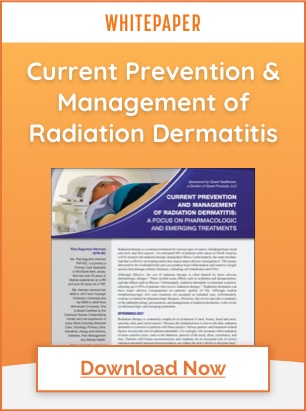
Impact of Radiation Therapy: Radiation Dermatitis
Radiation therapy remains an essential component of cancer treatment, with nearly 50% of cancer patients receiving radiation therapy at some point during the course of their illness.1 Acute and/or chronic skin changes may occur and carry the risk of influencing the quality of life during and after completion of radiation therapy.1 Of those receiving radiation therapy, as many as 95% may experience some form of radiation dermatitis, or radiation-induced skin injury.2
Pathophysiology
The high-energy X-rays used in modern radiation therapy produce both direct and indirect ionization events that not only result in injury to cancer cells, but also pose a risk of injury to normal tissues. A small fraction of rapidly proliferating cells in the basal layer of the skin are injured or destroyed when receiving a small daily dose of radiation. This can result in the peeling and shedding of the epidermis-depending on the total dose of radiation delivered.3 Impairment of the skin barrier carries the risks of wound formation, loss of immune function, and infection.4
Radiation can also damage the microvascular system, increasing the risk of tissue hypoxia and fibrosis, and activating an inflammatory cascade, leading to acute and chronic skin changes.4
Presentation of Radiation Dermatitis
The presentation of radiation dermatitis differs based on acute versus chronic skin changes.
The acute phase of radiation dermatitis is often defined as the changes seen within 90 days following radiation therapy. The development of acute radiation dermatitis follows a predictable course. These typically occur within days to weeks of therapy, and often involve early erythema that often abates within days. Other acute changes may include dryness, loss of hair, and hyperpigmentation.
In later weeks, dry desquamation (skin peeling) can occur, causing itchiness, flaking, and scaling of the skin.
Higher radiation doses may cause more severe cases, in which moist desquamation occurs and causes edema, exudate, and bullae formation.
Chronic radiation dermatitis occurs 90 or more days after completion of radiation therapy but may develop over a course of years. Signs include:
- Dermal atrophy
- Fibrosis
- Vascular injury
- Thinning of the epidermis
- Thickening of the dermis5
Prevention and Management of Radiation Dermatitis
Strategies for preventing and managing acute radiation dermatitis include:
- Topical prophylactic steroids for skin reaction
- Saline soaks for comfort
- Sitz baths, peri bottles as needed for perineal skin reactions
- Barrier protection
- Monitoring for and treating secondary infections as necessary
- Consult wound care for severe grade ¾ dermatitis5
Treating Radiation Dermatitis with ALOCANE® Plus
Radiation dermatitis can be painful and negatively affect health-related quality of life and healthcare costs. ALOCANE Plus® is an effective treatment for the temporary relief of minor pain and itching associated with radiation dermatitis.
ALOCANE Plus is a topical ointment containing 4% lidocaine (a topical analgesic) and 0.13% benzalkonium chloride (a topical antiseptic), along with other ingredients such as aloe vera and tocopheryl acetate (vitamin E). Lidocaine is a local anesthetic that exerts its analgesic effects through the inhibition of voltage-gated sodium channels in neurons, thus preventing the generation and conduction of nerve impulses. Benzalkonium chloride significantly reduces germs commonly associated with skin infections. Read all package directions before use.
Request ALOCANE Plus® samples for your radiation therapy patients today.
Request an Educational In-Service
Are you interested in learning more about this topic, among others, and educating those within your healthcare facility? Request a virtual 20-30 minute Educational In-Service for your team today, and we’ll even have lunch delivered to your office!
Disclaimer: The material contained is for reference purposes only. Quest Healthcare, A Division of Quest Products, LLC, does not assume responsibility for patient care. Consult a physician prior to use. Copyright 2023 Quest Healthcare, A Division of Quest Products, LLC.
Sources:
- Radiation Dermatitis: Recognition, Prevention, and Management, Cancer Network, December 15, 2017 Jonathan Leventhal, MD, Melissa Rasar Young, MD, PhD
- Singh M, Alavi A, Wong R, Akita S. Radiodermatitis: a review of our current understanding. Am J Clin Dermatol. 2016;17:277-92
- Koenig TR, Wolff D, Mettler FA, Wagner LK. Skin injuries from fluoroscopically guided procedures: part 1, characteristics of radiation injury. AJR Am J Roentgenol. 2001;177:3-11
- Haase O, Rodemann HP. Fibrosis and cytokine mechanisms: relevant in hadron therapy? Radiother Oncol. 2004;73(suppl 2):S144-S147
- Radiation Dermatitis: Recognition, Prevention, and Management Cancer Network December 15, 2017 Jonathan Leventhal, MD, Melissa Rasar Young, MD, PhD






![[Media Release] Focused Report: Clinician-Supported Emerging Treatment Options, Radiation Dermatitis](https://www.questhealthcare.net/wp-content/uploads/2022/04/Radiation-Dermatitis-whitepaper-500x383.png)
![[Media Release] Evidence-Based Treatment Options, Early Stage Pressure Injuries](https://www.questhealthcare.net/wp-content/uploads/2022/04/pressure-injuries-whitepaper-cover-500x383.png)